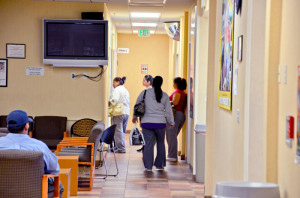
many patients have to wait long hours until they are
attended to.
There is a very high number of Latinos in the Bay Area who do not have health insurance.
According to a study by the American Coalition for a Healthy California, there are 6.3 million people throughout the state who have no health insurance, of which 54 percent are Latino.
One of the reasons contributing to the lack of health insurance is primarily unemployment rates, of which foreign-born Hispanics make up 70.8 percent, according to 2009 data from the Bureau of Labor Statistics.
This condition is reflected especially in the Latino community as many do not receive health insurance from their employers and, thus, neither do their spouses and children.
By 2010, Hispanics made up 16.3 percent of the U.S. population and are the fastest growing demographic.
This number reflects not only a growing population but a growing demographic in poverty.
Data gathered from the 2010 U.S. Census cites that 40.7 percent of the total 144,186 in Hayward are Hispanic. Since 2000 there has been an increase of 22.7 percent.
Nearly 40 percent of Latino children in the United States are overweight or obese, and as reported by the U.S. Department of Health & Human Services, in 2009 Hispanics were 1.2 times more likely to be obese than non-Hispanic whites.
With Obamacare and health care reform being controversial issues for the November ballot, the future of health care in America and how it will affect Latinos is at stake.
Many of them go to local clinics where either free or low-cost care is available.
Rosa Rivas, who is originally from El Salvador, came to the clinic Tiburcio Vazquez in Hayward to receive prenatal care, as she is pregnant for the second time.
“Having such clinics are good because they help the community, are close to my house and my children here can also be served,” said Rivas.
According to 2011 figures, the Tiburcio Vasquez Clinic in Hayward attended to 14,797 patients, of which 71 percent qualified as below federal poverty level and 75 percent were Latino.
The health clinic offers services such as dental, optometric and family planning, among others, saying it is important to help as many people as possible, as the economy affects people’s ability to live and survive.
Jessica Gardezy, associate of communications for Tiburcio Vazquez, said that “most people go to clinics because they lack health insurance and can not afford the high cost of going to a private hospital.”
“The clinics began as a last resort for low income or poor, and only last year we served 14,797 patients and also diagnose and treat patients with diseases such as HIV, tuberculosis, diabetes, asthma, cancer and diseases of heart,” Gardezy said.
Many CSU East Bay students also said they go to these clinics, as patients are not only attended to, but also because the center helps them find out how much they are able to afford depending on their economic status.
Tiburcio Vasquez has locations in Hayward, Union City and Fremont, and has maintained a presence in the East Bay for over 15 years.
Maria Lopez, a Mexican immigrant, goes to the clinic in Hayward for regular physicals and check-ups. “I come to get help here because the pay here is low compared with the pay in a hospital.”
Lopez is unemployed and therefore does not have insurance. Although she doesn’t get an appointment until two months later, she says the free or low cost assistance is worth the wait.
Many of these clinics are so busy and in demand, that many patients cannot be served until months later, patients said.
According to figures from Tiburcio Vasquez, 51 percent of their income comes from donations and contributions, 43 percent of the fees obtained from patients and four percent in-kind contributions and individual donations.
With the proceeds received, the services they provide to their patients in the community contribute to 86 percent of expenditures, 11 percent goes to overhead costs of the organization and the remaining 3 percent goes to maintenance.
While these options for Latinos like Lopez and Rivas continue to exist, they say they will continue seeking medical help in these clinics, even if they have to wait months to receive the medical attention they need.
They believe it is better than no medical care at all.
As such, the issue of Latino health and immigration health in general, experts say, is an issue in need of attention and resolution.











